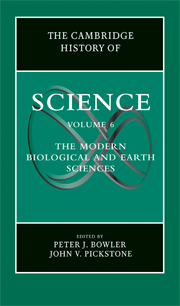Book contents
- Frontmatter
- 1 Introduction
- PART I WORKERS AND PLACES
- 2 Amateurs and Professionals
- 3 Discovery and Exploration
- 4 Museums
- 5 Field Stations and Surveys
- 6 Universities
- 7 Geological Industries
- 8 The Pharmaceutical Industries
- 9 Public and Environmental Health
- PART II ANALYSIS AND EXPERIMENTATION
- PART III NEW OBJECTS AND IDEAS
- PART IV SCIENCE AND CULTURE
- Index
- References
3 - Discovery and Exploration
from PART I - WORKERS AND PLACES
Published online by Cambridge University Press: 28 November 2009
- Frontmatter
- 1 Introduction
- PART I WORKERS AND PLACES
- 2 Amateurs and Professionals
- 3 Discovery and Exploration
- 4 Museums
- 5 Field Stations and Surveys
- 6 Universities
- 7 Geological Industries
- 8 The Pharmaceutical Industries
- 9 Public and Environmental Health
- PART II ANALYSIS AND EXPERIMENTATION
- PART III NEW OBJECTS AND IDEAS
- PART IV SCIENCE AND CULTURE
- Index
- References
Summary
In May 2003, from the Baikanur launchpad in the Central Asian deserts of Kazakhstan, British scientists fired a Russian Soyuz-Fregat rocket to launch a probe called the Mars Express, intended to determine whether recognizable chemical signs of life could be found in the thin atmosphere and dusty rocks of the red planet. In 1971, the Soviets had been the first to land a probe on Mars, and they were followed by the American Viking missions in 1976. In January 2004, the U.S. National Aeronautics and Space Administration (NASA) landed the mobile rovers Spirit and Opportunity on Mars. These represented huge and dangerous efforts. Of thirty previous missions to Mars, twenty had gone seriously wrong. In 2003, a British probe intended to explore the Martian surface, called – significantly – Beagle-2, failed to arrive on the surface. The European mission cost 300 million euros and the American mission ten times as much. Behind all these efforts lies the necessity of securing wide political and public support. Thus, the space missions are performed in “full view of the public.” As Alan Wells, director of space research at the University of Leicester, put it, “We are breaking new ground in the public presentation of space science.” His duty, in his words, is to be a professor of public relations as well as planetary science.
- Type
- Chapter
- Information
- The Cambridge History of Science , pp. 34 - 59Publisher: Cambridge University PressPrint publication year: 2009
References
- 15
- Cited by



